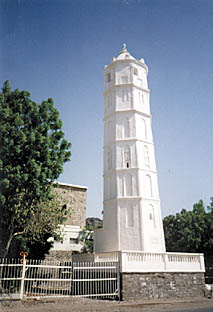
Aden Minaret: Beacon of Light Though Time [Archives:1998/36/Last Page]
September 7 1998
Historical evidence indicates that, centuries ago, there used be more mosques in Aden than now. These were not places solely devoted to worship, but also institutes of learning Arabic, jurisprudence, and other topics of religion. Scholars used to come from around the Islamic world to teach and to learn in Aden’s mosques.
When the British arrived in Aden in 1839, only two historical mosques were still standing. One of these is Al-Jami’ Minaret.

The famous Minaret lies in Crater, Aden, on the western side of the Army Football Stadium – within a small public garden near Aden’s General Post Office.
This octagonal edifice, 21m high, consists of six stories. A spiral staircase within the Minaret leads to the top where the Muadin calls the faithful to prayer five times a day.
Debatable Balustrade
Some people say that the stone platform and the square balustrade running around the base of the Minaret was not there in the 1940s. The platform was erected to save the Minaret from keeling over. While others claim that these structures are older than the Minaret itself.
Beacon
In pre-Islamic times, the Aden Minaret, some historians claim, also served as a light-house directing ships safely into the Seera harbor on many a stormy night. They cite the fact that the space allocated for the Muadin at the top of the Minaret is not large enough for a man to stand fully erect as evidence that the original purpose of the Minaret was a light beacon.
Where is the Mosque?!
All historians agree that the large old mosque, of which the Aden Minaret is part, became dilapidated and was demolished ages ago. During the 1960s while excavation work was done in the vicinity of the Minaret, four abacuses with Islamic-style carvings were found – probably the remains of the mosque. Also, an old Muslim cemetery was discovered in the site.
Portuguese Sketches
Drawings dating back to 1512 AD, made by Portuguese artists and merchants passing through Aden on their way to southern India and South-East Asia, show three different mosques in that area. One of them is, of course, the Jami’ Al-Manara (the mosque of the minaret).
Haroldif Testifies
A book by the British auhtor Haroldif Jacob indicates that when the British first came to Aden, the Jami’ Al-Manara was still standing. It was supposedly built by Suleiman Al-Adhm (died 926 AD) during the Ottoman occupation of Yemen.
The exact year in which the mosque was built, however, is still a source of heated debate by historians. Old Yemeni historians show that the Aden Minaret is what remains of a very old mosque erected by the righteous Ummayad Caliph Omar Bin Abdulaziz. Only Ibn Al-Mojawir, the venerated Yemeni historian, chose to differ. He said that the mosque was built by the Persians.
Ambergris
Folk tales had it that people in Aden found a large quantity of ambergris washed ashore. The governor of Aden then the sold the ambergris to merchants, and the money used towards building the Jami’s Al-Manara. This was actually more than folklore. The Yemeni historian Ba-Makhram emphasized it as historical fact.
Large Space for Prayer
Whatever the origin of the Aden Minaret, all historians agree that the mosque to which it is attached was a very large one. It was a central place where Adenis congregated to pray and to attend seminars conducted by renowned Muslim scholars.
The famous historian Al-Maqdisi Al-Bishari (died 990 AD) indicated that he said Tarawih prayers in the Jami’ Al-Manara, where Al-Hussain Bin Al-Siddiq Al-Ahdal taught jurisprudence and Arabic grammar.
According to many historians, relying on solid historic evidence, the Minaret is a pre-Islamic construction that was used as a light house. Others date the Minaret as only 1,200 years old.
Ridhwan Al-Saqqaf,
Yemen Times, Aden
——
[archive-e:36-v:1998-y:1998-d:1998-09-07-p:./1998/iss36/lastpage.htm]


